Qiu X.G. (Ed.) High Temperature Superconductors
Подождите немного. Документ загружается.

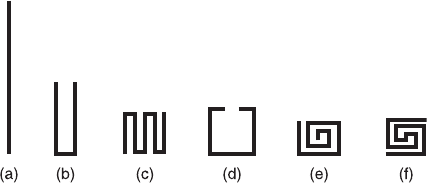
402 High-temperature superconductors
1
2
3
4
5
6
7
8
9
10
1
2
3
4
5
6
7
8
9
20
1
2
3
4
5
6
7
8
9
30
1
2
3
4
5
6
7
8
9
40
1
2
43X
© Woodhead Publishing Limited, 2011
one dimensional HTS transmission line resonators frequently used in applications
are coplanar waveguide (CPW) resonators and microstrip resonators. Because the
circuit structure and the ground planes are fabricated on a single plane, CPW
resonators offer the possibility of integration with active components. But the
electromagnetic energy in the CPW resonators are more confined to a small area
between the HTS line and the ground lines, so they tend to have lower quality
factors compared to other types of HTS resonators. Microstrip resonators are the
most popular type of resonators used in HTS microwave filters. Besides their
relatively high quality factor and small size, the ease with which they can be used
in a variety of coupling structures is also a big advantage. For most applications,
the basic shape of an HTS microstrip resonator is a half-wavelength (Fig. 10.8(a))
line instead of a grounded quarter-wavelength (
λ
/4) line, due to the difficulty of
realizing ground via HTS substrate. The conventional
λ
/2 resonator can be
miniaturized by folding its straight rectangular ribbon. The height of a folded
resonator, called a hairpin resonator (Fig. 10.8(b)), is usually less than
λ
/4.
Meander-line resonators (Fig. 10.8(c)), meander-loop resonators (Fig. 10.8(d)),
spiral resonators (Fig. 10.8(e)) and spiral-in-spiral-out resonators (Fig. 10.8(f))
are created as modifications of the conventional straight ribbon (
λ
/2) resonator by
folding the ribbons several times and in different ways. In principle,
λ
/2 resonators
can be folded or transformed to any other shape, according to the demands of
miniaturization or another purpose.
10.3.4 Other related superconducting microwave passive
devices: antennas and filters
As mentioned above, delay lines and resonators, which are all passive microwave
devices, are ideal vehicles for demonstrating the advantages of HTS. The main
advantage gained from HTS is low surface resistance, which can be directly
converted into small insertion loss or high Q-values for the microwave devices.
Another unique property of superconductors is their lack of dispersion due to the
10.8 Typical one dimensional microstrip resonators: (a) half-
wavelength line resonator; (b) hairpin resonator; and (c) to (f) other
open loop resonators.
Microwave filters using high-temperature superconductors 403
1
2
3
4
5
6
7
8
9
10
1
2
3
4
5
6
7
8
9
20
1
2
3
4
5
6
7
8
9
30
1
2
3
4
5
6
7
8
9
40
1
2
43X
© Woodhead Publishing Limited, 2011
fact that their penetration depth does not vary with frequency. Furthermore,
substrates with high dielectric constants, which are used for superconducting films,
make device miniaturization possible. Based on these advantages, more HTS
passive devices can be constructed for applications. Antennas can benefit in a
number of ways from the use of superconductors. One obvious application of
superconductors is in the improvement of radiation efficiency in small antennas.
For antennas with comparable size and wavelength, their efficiency is fairly high.
However, for those with dimensions that are small compared to their wavelength,
which are defined as electrically small antennas, efficiency is reduced due to the
increasing dominance of ohmic losses. By using extremely low loss superconductors,
reasonable efficiency can be achieved. Superconductors are also useful in feeding
and matching networks for super-directive antennas, which are very inefficient.
High Q-value matching networks, provided by superconducting circuits, help
considerably in terms of performance improvement. Another application of
superconductors to antennas is in the feed networks of millimetre-wave antennas.
The losses associated with long narrow microstrip feed lines can be improved
considerably if superconductors are used. This is especially true for arrays with a
large number of elements.
The most attractive applications of HTS in passive devices are those of filters.
Due to the very small surface resistance of HTS films, filters can be constructed
with remarkably high performance, i.e. with negligible insertion loss, very large
out-of-band rejection, and extremely steep skirt slopes. They can reduce the band
width and make ultra-narrow band filter possible. With the properties mentioned
above, excellent performance HTS filters can eliminate unwanted interference,
while maintaining a minimal noise figure in the system. Moreover, by using HTS
films the filter can be miniaturized due to not only special substrates being employed,
but also to new geometric designs being invented. In the past twenty years, various
kinds of HTS filters have been constructed and successful applications in many
fields have been realized, including those in direct data distribution between earth to
satellite and satellite to satellite (Romanofsky el al., 2000), detection of deep space
radio astronomy (Wallage et al., 1997; Li et al., 2003), base stations for mobile
communications (STI Inc., 1996; Hong et al., 1999) and meteorological radars for
weather forecasting (Zhang et al., 2007).
10.4 Superconducting filter and receiver front-end
subsystem
10.4.1 Principles and theories on filter design
Frequency-selective transmission is a property of electrical filters, which enables
them to transmit energy in one or more passbands, and to attenuate energy in one
or more stopbands. Filters are essential elements in many areas of RF/microwave
engineering.

404 High-temperature superconductors
1
2
3
4
5
6
7
8
9
10
1
2
3
4
5
6
7
8
9
20
1
2
3
4
5
6
7
8
9
30
1
2
3
4
5
6
7
8
9
40
1
2
43X
© Woodhead Publishing Limited, 2011
A filter is essentially a two port network. For linear, time-invariant two-port
filter networks, the transmission and reflection function may be defined as rational
functions,
[10.9]
where
ε
is a ripple constant, N(p), E(p) and D(p) are characteristic polynomials in
a complex frequency variable p =
σ
+ jΩ, and Ω is the normalized frequency
variable. For a lossless passive network,
σ
= 0 and p = jΩ. The horizontal axis
of the p plane is called the real axis, while the vertical axis is called the
imaginary axis. The values of p at which S
21
(p) becomes zero are the transmission
zeros of the filter, the values at which S
11
(p) becomes zero are the reflection zeros
of the filter, and the values at which S
21
(p) becomes infinite are the poles of the
filter.
Filters may be classified in several ways. The main categories are defined in
terms of the general response types: low-pass, bandpass, high-pass, and bandstop.
Filters can also be classified by their transmission zeros and poles. The Butterworth
filter is called a maximum flat response filter because its amplitude-squared
transfer function has a maximum number of zero derivatives at
Ω
= 0.
The Chebyshev filter exhibits an equal-ripple passband response and maximally
flat stopband response. All the transmission zeros of S
21
(p) of Chebyshev and
Butterworth filters are located at infinite frequencies. When one or more
transmission zeros are introduced into the stopband of a Chebyshev filter at
finite frequencies the filter is known as a generalized Chebyshev filter, or as a
quasi-elliptic filter. The special case where the maximum number of transmission
zeros is located at finite frequencies, such that the stopbands have equal rejection
level, is the well-known elliptic function filter. This is now rarely used due to
problems associated with its practical realization. The Gaussian filter, unlike
those mentioned above, has poor selectivity but a fairly flat group delay in the
passband.
Chebyshev filters have for many years found frequent application within
microwave space and terrestrial communication systems. The generic features of
equal ripple passband characteristics, together with the sharp cutoffs at the edges
of the passband and hence high selectivity, offer an acceptable compromise
between lowest signal degradation and highest noise/interference rejection. As the
frequency spectrum becomes more crowded, specifications for channel filters
have tended to become very much more severe. Very high close-to-band rejections
are required to prevent interference to or from closely neighbouring channels; at
the same time, there is a demand for the incompatible requirements of in-band
group-delay and amplitude flatness and symmetry to minimize signal degradation.
With a generalized Chebyshev filter, it is easy to build-in prescribed transmission
zeros for improving the close-to-band rejection slopes and/or linearizing the
in-band group delay. Therefore, generalized Chebyshev filters have been
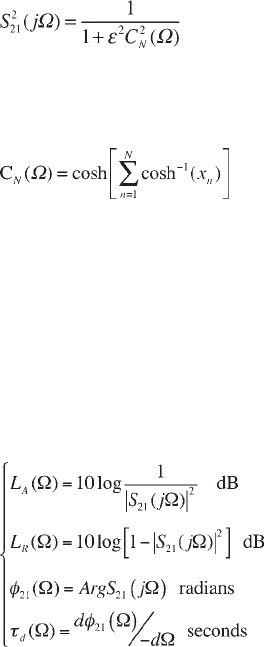
Microwave filters using high-temperature superconductors 405
1
2
3
4
5
6
7
8
9
10
1
2
3
4
5
6
7
8
9
20
1
2
3
4
5
6
7
8
9
30
1
2
3
4
5
6
7
8
9
40
1
2
43X
© Woodhead Publishing Limited, 2011
extensively investigated by many researchers over the last few decades. Coupled
resonator circuits are of importance for the design of generalized Chebyshev
filters. This design method is based on coupling coefficients of inter-coupled
resonators and the external quality factors of input and output resonators. One of
the fundamental methods for the synthesis of generalized Chebyshev filters based
on cross-coupled resonators was proposed by Atia and Williams (1972; Atia et al.,
1974), and is still commonly used. Alternative synthesis techniques were also
advanced by many scientists (Cameron and Rhodes, 1981; Chambers and Rhodes,
1983; Levy, 1995; Cameron, 1999).
The first step in designing a generalized Chebyshev filter is to determine all the
positions of the transmission zeros and reflection zeros of the filter that satisfy the
specifications. The amplitude-squared transfer function for a lossless low-pass
prototype is defined as
[10.10]
where
ε
is related to the passband return loss (RL) by
ε
= [10
RL/10
– 1]
1/2
, and
C
N
(Ω) represents a filtering or characteristic function with N being the order of
the filter. For a generalized Chebyshev filter, C
N
(Ω) may be expressed as
[10.11]
where, x
n
= (Ω – 1/Ω)/(1 – Ω/Ω
n
), and Ω
n
is the position of the nth prescribed
transmission zero.
It can be proved (Cameron and Rhodes, 1981) that C
N
(Ω) can be expressed as
a ratio of N(p), E(p). Given that all the transmission zeros and RL various methods
exist for evaluating the characteristic polynomials N(p), E(p) and D(p) (Cameron,
1999; Amari, 2000; Macchiarella, 2002), then the reflection zeros and poles of the
filter may be found by rooting E(p) and D(p), respectively. Then the complete
transmission response L
A
, reflection response L
R
, and phase response
Φ
21
,
including the group delay
τ
d
, can be computed by
[10.12]
and so can the lowpass to bandpass frequency transformation: Ω = (1/FBW) ×
(
ω
/
ω
0
–
ω
0
/
ω
), where
ω
0
is the centre frequency of the bandpass filter, and FBW
is the fractional bandwidth.
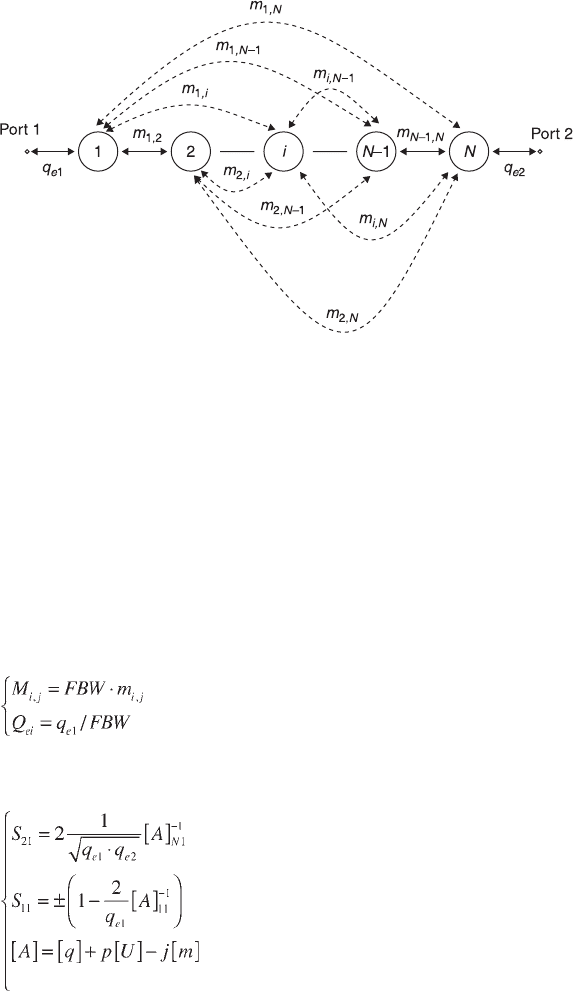
406 High-temperature superconductors
1
2
3
4
5
6
7
8
9
10
1
2
3
4
5
6
7
8
9
20
1
2
3
4
5
6
7
8
9
30
1
2
3
4
5
6
7
8
9
40
1
2
43X
© Woodhead Publishing Limited, 2011
Knowing all the positions of the zeros and poles, the next step of filter synthesis
is to choose an appropriate topology of coupled resonators and to synthesize the
coupling matrix. Figure 10.9 shows a schematic illustration of a filtering circuit of
N coupled resonators, where each circle with a number represents a resonator, which
can be of any type despite its physical structure. m
i,j
with two subscript numbers is
the normalized coupling coefficient between the two (i
th
and j
th
) resonators and q
e1
and q
e2
are the normalized external quality factors of the input and output resonators.
Here, we assume
ω
0
= 1 and FBW = 1. For a practical filter, the coupling coefficient
M
i,j
and external quality factors Q
e1
, Q
e2
can be computed by
[10.13]
The transfer and reflection functions of a filter with coupling topology in
Fig. 10.9 are
[10.14]
where p is the complex frequency variable as defined before, [U] is the N × N
identity matrix, [q] is an N × N matrix with all entries zero except for q
11
= 1/q
e1
and q
NN
= 1/q
e2
, and [m] is an N × N reciprocal symmetrical matrix being named
10.9 The general coupling structure of a filtering circuit of N coupled
resonators.
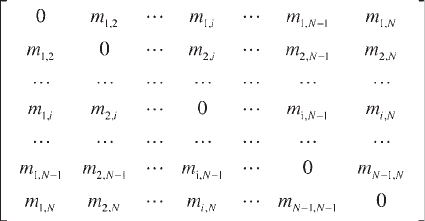
Microwave filters using high-temperature superconductors 407
1
2
3
4
5
6
7
8
9
10
1
2
3
4
5
6
7
8
9
20
1
2
3
4
5
6
7
8
9
30
1
2
3
4
5
6
7
8
9
40
1
2
43X
© Woodhead Publishing Limited, 2011
as the general coupling matrix. The non-zero values may occur in the diagonal
entries of [m] for electrically asymmetric networks representing the offsets from
the centre frequency of each resonance (asynchronously tuned). However, for a
synchronously tuned filter, all the diagonal entries of [m] will be zero and [m] will
have the form
The minor diagonal entries of [m] all have non-zero values. They represent
couplings between adjacent resonators and, in the remainder of the paper, they are
called direct couplings. The other entries represent couplings between non-adjacent
resonators. It is this type of couplings which create transmission zeros of filter
response. Those entries may all have non-zero values in theory, which means that
in the filter network that [m] represents, couplings exist between every resonator
and every other non-adjacent resonator. This is clearly impractical in the case of
cavity type resonators. In the case of planar resonators such as HTS microstrip
resonators, couplings may exist between every resonator and every other non-
adjacent resonator. However, it is still impractical to handle all those couplings as
expected. So it is important to choose a realizable coupling topology to design a
practical filter, which means some particular non-adjacent couplings are chosen to
exist, and the others are not. Generally, the desired non-adjacent couplings are
called cross-couplings, while the others are called parasitical couplings.
There are three frequently used coupling topologies in the design of generalized
Chebyshev filters, as shown in Fig. 10.10, where each circle with a number
represents a resonator, full lines indicate the direct couplings, and the broken lines
denote cross-couplings. In the cascaded quadruplet (CQ) topology, four resonators
construct a quadruplet section, as illustrated in Fig. 10.10(a), and then it can be
cascaded to other resonators or quadruplets. Each quadruplet section will create a
pair of transmission zeros which are symmetric with respect to the centre
frequency. Similar to the CQ filter, three resonators can construct a trisection
structure, as shown in Fig. 10.10(b), and this can then be cascaded to other
resonators or trisections to form a cascaded trisection (CT) filter. Each trisection
structure, however, will only create one transmission zero. So the frequency
response in a CT filter could be asymmetrical. The cross-couplings between
different CQ or CT sections are independent of each other, making the tuning of
the filter relatively easy. The coupling topology shown in Fig. 10.10(c) is the

408 High-temperature superconductors
1
2
3
4
5
6
7
8
9
10
1
2
3
4
5
6
7
8
9
20
1
2
3
4
5
6
7
8
9
30
1
2
3
4
5
6
7
8
9
40
1
2
43X
© Woodhead Publishing Limited, 2011
so-called canonical fold form. The canonical fold coupling section always contains
an even number of resonators. For a filter consisting of 2n resonators, 2n – 2
transmission zeros can be realized. So, a given out-of-band rejection specification
can meet it by fewer resonators in the canonical fold filter than in the CQ or CT
structures. However, the effect of each cross-coupling in a canonical fold filter is
not independent, which makes the filter tuning more difficult.
Once an appropriate coupling topology is determined, the synthesis from
characteristic polynomials to coupling matrix may follow the steps of Atia et al.
(1972, 1974). They used the orthonormalization technique to obtain a general
coupling matrix with all possible cross-couplings present, and repeated similarity
transformations are then used to cancel the unwanted couplings to obtain a suitable
form of the prototype. Unfortunately, the processes do not always converge. In this
case, an optimization technique is a good alternative to derive the sequence of
transformations, allowing for annihilation of the unwanted elements and providing
the matrix with the required topology (Chambers and Rhodes 1983; Atia et al.,
1998; Levy, 1995). Generally, the desired couplings in the optimization are evaluated
by minimizing a cost function involving the values S
11
and S
21
at specially selected
frequency points, such as those at transmission and reflection zeros. The entries of
the coupling matrix are used as independent variables in the optimization process.
The final step in the design of a filter is to find an appropriate resonator and
convert the coupling matrix into practical physical structures. Readers can find
detailed instructions on how to establish the relationship between the values of
every required coupling coefficient and the physical structure of coupled resonators
in the book by Hong and Lancaster (2001). In this step it is essential to employ the
help of computer-aided design (CAD), particularly full-wave electromagnetic
(EM) simulation software. EM simulation software solves Maxwell equations
with the boundary conditions imposed upon the RF/microwave structure to be
modelled. They can accurately model a wide range of such structures.
10.4.2 Resonators for superconducting filter design
Resonators are key elements in a filter, which play a large part in deciding the
performance of the filter. The HTS resonators suitable for developing narrow-
10.10 Three frequently used coupling topologies in generalized
Chebyshev filters. For explanation see text.
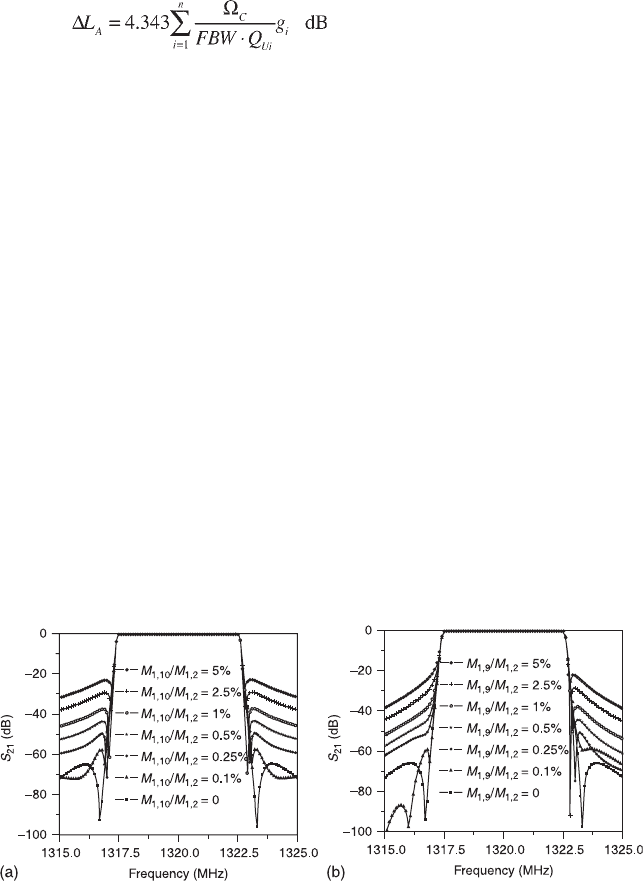
Microwave filters using high-temperature superconductors 409
1
2
3
4
5
6
7
8
9
10
1
2
3
4
5
6
7
8
9
20
1
2
3
4
5
6
7
8
9
30
1
2
3
4
5
6
7
8
9
40
1
2
43X
© Woodhead Publishing Limited, 2011
band generalized Chebyshev filters should demonstrate the high-quality factors,
minimized size, and convenience to realize cross couplings. For an n-pole
bandpass filter, the quality factors of resonators directly related to the insertion
loss of a filter may be described as
[10.15]
where ∆L
A
is the dB increase in insertion loss at the centre frequency of the filter, Q
ui
is the unloaded quality factor of the i
th
resonator evaluated at the centre frequency,
and g
i
is either the inductance or the capacitance of the normalized lowpass prototype.
In the design of narrow band microstrip filters, one important consideration
in selecting resonators is to avoid parasitical couplings between non-adjacent
resonators. Those parasitical couplings may decrease the out-of-band rejection level
and/or deteriorate the in-band return loss of the filter. For example, consider a
10-pole CQ filter which has a pair of transmission zeros (the design of this filter will
be detailed in the next section). The transmission zeros are created by two identical
cross-couplings between resonators 2 and 5 and between resonators 6 and 9. All the
other non-adjacent couplings should be zero, according to the coupling matrix.
However, because all the resonators are located in one piece of dielectric substrate
and in one metal housing, parasitical couplings between non-adjacent resonators are
inevitable. We have performed a series of analyses by computer simulation on how
parasitical couplings affect the transmission response of this 10-pole CQ filter, and
the results are plotted in Fig. 10.11. In Fig. 10.11(a) different levels of the parasitical
coupling between resonator 1 and 10 (M
1,10
) were assumed. Its magnitude is scaled
to the main coupling M
1,2
. A significant degeneration of the out-of-band rejection
level can be seen when M
1,10
is higher than 0.1 percent of M
1,2
. In Fig. 10.11(b) the
effects of the parasitical coupling between resonator 1 and 9 (M
1,9
) with different
strengths were also simulated. It can be seen that in addition to the degeneration of
10.11 Illustration of how the parasitical couplings affect the response
of a narrow band bandpass filter.

410 High-temperature superconductors
1
2
3
4
5
6
7
8
9
10
1
2
3
4
5
6
7
8
9
20
1
2
3
4
5
6
7
8
9
30
1
2
3
4
5
6
7
8
9
40
1
2
43X
© Woodhead Publishing Limited, 2011
the out-of-band rejection level, the presence of M
1,9
also causes the asymmetric
transmission response of the filter. To solve these parasitical coupling problems, it is
necessary to employ some unique resonators. For example, the hairpin and spiral-
in-spiral-out resonators (as depicted in Fig. 10.8) behave as though they have two
parallel-coupled microstrips excited in the odd mode when resonating. In this case,
the currents in these two microstrips are equal and opposite, resulting in the
cancellation of their radiation fields. This characteristic should be of great help in
reducing parasitical couplings when designing narrow band filters.
10.4.3 Superconducting filter and receiver front-end
subsystem
So far, the theory and principles of HTS filter design have been discussed
generally. In this section, the design, construction and integration of a real practical
HTS filter and HTS receiver front-end subsystem will be introduced as an
application example with one special type of meteorological radar: the wind
profiler. The frequencies assigned to the wind profiler are in UHF and L band,
which are very crowded and noisy with radio, TV, and mobile communication
signals, and therefore the radar is often paralysed by the interference. To solve this
problem, it is necessary to employ pre-selective filters. Unfortunately, due to the
extremely narrow bandwidth (≤ 0.5%) there is no suitable conventional device
available. The HTS filter can be designed to have very narrow bandwidth and
very high rejection with very small loss, therefore it is expected that the HTS
filter can help to improve the anti-interference ability of the wind profiler, without
even a tiny reduction in its sensitivity. In fact, because the low noise amplifier
(LNA) in the front end of the receiver is also working at a very low temperature
in the HTS subsystem, the sensitivity of the radar will actually be increased.
The centre frequency of the wind profiler introduced here is 1320 MHz. In
order to reject the near band interference efficiently, the filter was expected to
have a bandwidth of 5 MHz and for its skirt slope to be as sharp as possible. It has
been decided that the real design should employ a 10-pole generalized Chebyshev
function filter with a pair of transmission zeros placed at Ω = ± 1.3 so as to
produce a rejection lobe better than 60 dB on both sides of the passband. For the
implementation of this filter, the CQ coupling topology shown in Fig.10.12 was
10.12 Coupling topology of the 10-pole CQ filter designed for the wind
profiler.
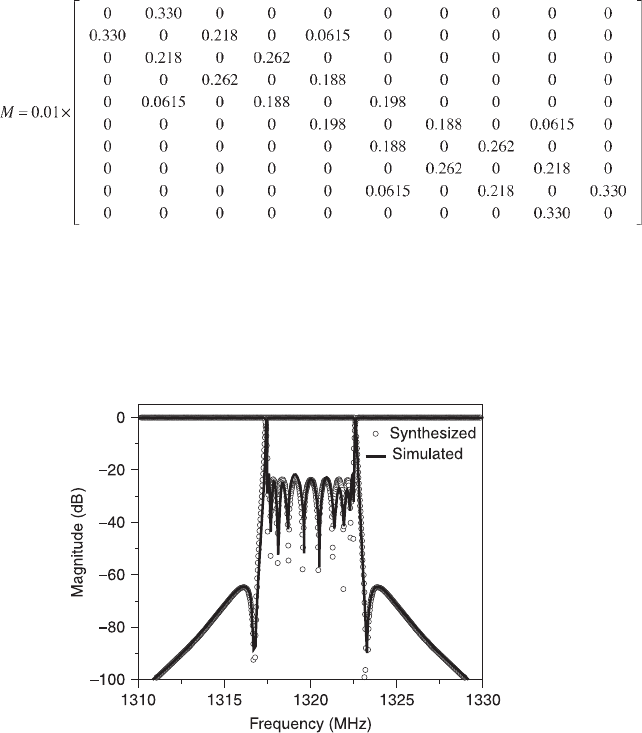
Microwave filters using high-temperature superconductors 411
1
2
3
4
5
6
7
8
9
10
1
2
3
4
5
6
7
8
9
20
1
2
3
4
5
6
7
8
9
30
1
2
3
4
5
6
7
8
9
40
1
2
43X
© Woodhead Publishing Limited, 2011
employed. The cross couplings M
2,5
and M
6,9
in Fig.10.12 were introduced to
create the desired transmission zeros. In the present design, they are set to be
equal to each other to create the same pair of transmission zeros. Introducing two
identical cross couplings can make the physical structure of the filter symmetric.
With this strictly symmetric physical structure, only half (e.g., the left half) of the
whole filter needs to be simulated in the EM simulation process, which will
simplify the EM simulation and save a considerable amount of computing time.
The transfer and reflection functions and the coupling matrix can then be
synthesized following the instructions in section 10.4.1. For this filter with
topologic structure, shown in Fig. 10.12, the finally coupling parameters are:
Q
e1
= Q
e2
= 237.3812, and
The synthesized response of the filter is depicted in Fig. 10.13. The designed
filter shows a symmetric response which gives a rejection lobe of more than 60 dB
on both sides of the passband, as expected. The passband return loss is 22 dB and
the band width is 5 MHz, centred at 1320 MHz. Two transmission zeros are
located at 1316.75 MHz and 1320.25 MHz, respectively.
10.13 Synthesized (circles) and simulated (solid line) responses of the
10-pole CQ filter.
